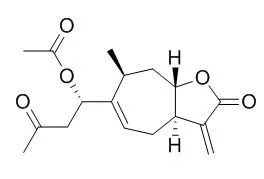| In vitro: |
| Molecules. 2015 Apr 17;20(4):7034-47. | | Phytochemical compositions and biological activities of essential oil from Xanthium strumarium L.[Pubmed: 25898416] | The chemical composition of the essential oil (EO) from fresh cocklebur (Xanthium strumarium L.) leaves was investigated by GC-MS.
METHODS AND RESULTS:
The antimicrobial activity of the EO was tested against Gram-positive and Gram-negative bacteria and fungi. Scolicidal activity was assayed against Echinococcus granulosus protoscolices. In total, 34 compounds were identified, accounting for 98.96% of the EO. The main compounds in the EO were cis-β-guaiene (34.2%), limonene (20.3%), borneol (11.6%), bornyl acetate (4.5%), β-cubebene (3.8%), sabinene (3.6%), phytol (3.1%), β-selinene (2.8%), camphene (2.2%), α-cubebene (2.4%), β-caryophyllene (1.9%), α-pinene (1.8%) and Xanthinin (1.04%). The antibacterial and antifungal screening of the EO showed that all assayed concentrations significantly inhibited the growth of Staphylococcus aureus, Bacillus subtilis, Klebsiella pneumoniae, Pseudomonas aeruginosa, Candida albicans and Aspergillus niger (MIC = 0.5 ± 0.1, 1.3 ± 0.0, 4.8 ± 0.0, 20.5 ± 0.3, 55.2 ± 0.0 and 34.3 ± 0.0 µg/mL, respectively). The scolicidal assay indicated that the EO exhibited a significant activity against E. granulosus protoscolices.
CONCLUSIONS:
To the best of our knowledge, this is the first report on the scolicidal activity of X. strumarium. Because of the emergence of antimicrobial drug resistance, the study of new effective natural chemotherapeutic agents, such as the X. strumarium EO, possibly with low side effects, represents a very promising approach in biomedical research. | | Eur J Med Chem. 2015 Jan 27;90:491-6. | | Optimization of xanthatin extraction from Xanthium spinosum L. and its cytotoxic, anti-angiogenesis and antiviral properties.[Pubmed: 25481815] |
METHODS AND RESULTS:
The aqueous extraction of the sesquiterpene lactone xanthatin from Xanthium spinosum L. favours the conversion of Xanthinin (1) to xanthatin (2) via the loss of acetic acid. The cytotoxic (Hep-G2 and L1210 human cell lines) and antiviral activities of isolated xanthatin are established.
CONCLUSIONS:
This natural compound shows significant cytotoxicity against the Hep-G2 cell line and our experimental results reveal its strong anti-angiogenesis capacity in vitro. The structure of xanthatin is determined by spectroscopic methods and for the first time confirmed by X-ray diffraction. | | Allelopathy J., 2015, 35(1):77-86. | | Selective phytotoxicity of xanthinin and xanthatin from invasive weed Xanthium italicum Morretti on test plants[Reference: WebLink] |
METHODS AND RESULTS:
Two phytotoxic xanthanolides, Xanthinin and xanthatin, were isolated from the leaves and fruits of invasive weed, Xanthium italicum Morretti, commonly known as Italian cocklebur. They slightly inhibited the seedling growth of Italian cocklebur, but were very inhibitory to lettuce, ryegrass and two indigenous species (African rue and redroot pigweed). Xanthinin significantly decreased the growth of lettuce (Lectuca sativa L.), ryegrass (Lolium multiforum Lam.), Syrian me (Peganum harmala L.) and redroot pigweed (Amaranthus retroflexus L.) even at low concentration (10 mu g/mL). In contrast, the root length of Italian cocklebur slightly inhibited (2%) compared to control at 50 mu g/mL Xanthinin treatment. The application of xanthatin also inhibited the growth of receiver plants. Ryegrass and Syrian rue were most sensitive species, whose root growth was inhibited by 78% and 96%, respectively, at 50 mu g/mL dose of xanthatin, while the root length of Italian cocklebur was only inhibited by 23%. In fact, Italian cocklebur was the only receiver species that survived at 1 mg/mL xanthatin and Xanthinin treatment.
CONCLUSIONS:
Our results suggested that the selective phytotoxicity of Italian cocklebur and other species facilitated its successful invasion. This is the first report on the phytotoxic activity of xanthatin. |
|






 Cell. 2018 Jan 11;172(1-2):249-261.e12. doi: 10.1016/j.cell.2017.12.019.IF=36.216(2019)
Cell. 2018 Jan 11;172(1-2):249-261.e12. doi: 10.1016/j.cell.2017.12.019.IF=36.216(2019) Cell Metab. 2020 Mar 3;31(3):534-548.e5. doi: 10.1016/j.cmet.2020.01.002.IF=22.415(2019)
Cell Metab. 2020 Mar 3;31(3):534-548.e5. doi: 10.1016/j.cmet.2020.01.002.IF=22.415(2019) Mol Cell. 2017 Nov 16;68(4):673-685.e6. doi: 10.1016/j.molcel.2017.10.022.IF=14.548(2019)
Mol Cell. 2017 Nov 16;68(4):673-685.e6. doi: 10.1016/j.molcel.2017.10.022.IF=14.548(2019)